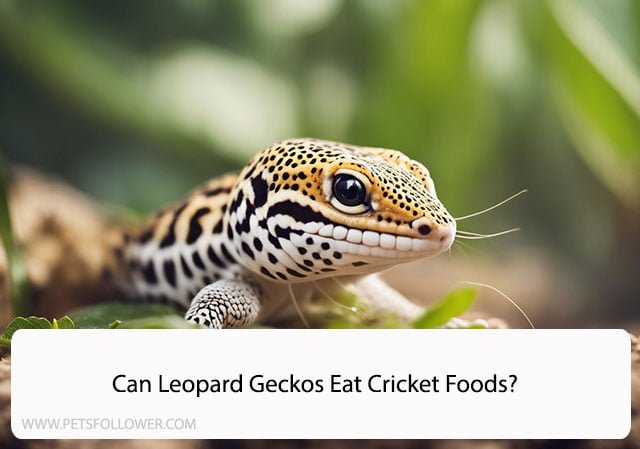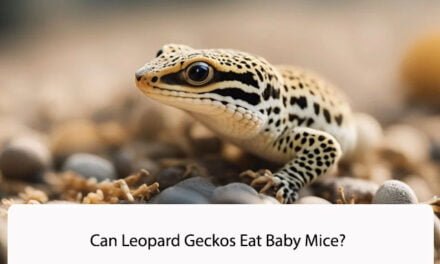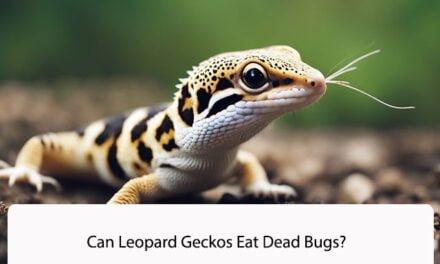Leopard geckos are popular pets that are known for their unique appearance and docile temperament. As a responsible pet owner, it’s important to understand what foods are safe and healthy for your gecko to eat. One common question that many gecko owners have is whether or not their pets can eat cricket foods.

Crickets are a common food source for leopard geckos in captivity, but not all cricket foods are created equal. Some cricket foods may contain ingredients that are harmful to your gecko, while others may not provide the necessary nutrients for a balanced diet. It’s important to do your research and choose a high-quality cricket food that is specifically formulated for leopard geckos.
In this article, we will explore the topic of whether or not leopard geckos can eat cricket foods. We will discuss the nutritional needs of leopard geckos, the different types of cricket foods available on the market, and how to choose the best cricket food for your pet. By the end of this article, you will have a better understanding of what foods are safe and healthy for your leopard gecko to eat.
Dietary Basics of Leopard Geckos
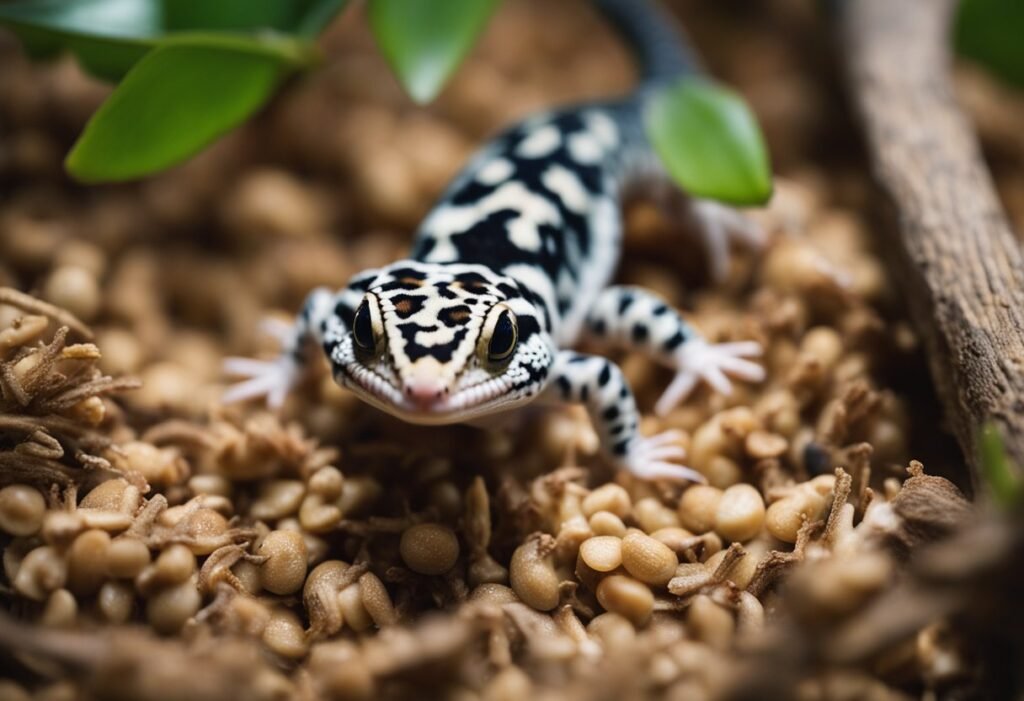
Leopard geckos are insectivores, meaning they eat insects as their primary source of nutrition. In the wild, they eat a variety of insects, including crickets, mealworms, waxworms, and roaches. In captivity, they can be fed a diet consisting solely of crickets, but it is important to ensure that their diet is balanced and meets their nutritional needs.
Leopard geckos require a diet that is high in protein and low in fat. Crickets are a great source of protein for leopard geckos, but they should be gut-loaded before feeding to ensure that they are nutritionally balanced. This means feeding the crickets a nutritious diet before feeding them to the leopard gecko. Commercial cricket foods can be used to gut-load crickets, or they can be fed a diet of vegetables and fruits.
In addition to protein, leopard geckos require calcium and other vitamins and minerals to maintain their health. Calcium is particularly important for leopard geckos, as they require it to maintain strong bones and prevent metabolic bone disease. Dusting crickets with a calcium supplement before feeding them to the leopard gecko is recommended to ensure that they are getting enough calcium.
It is important to note that leopard geckos have different dietary requirements depending on their age and size. Juvenile leopard geckos require more protein than adult leopard geckos, and they should be fed more frequently. Adult leopard geckos should be fed a diet that is lower in protein and higher in fat to maintain their weight and overall health.
In summary, crickets can be a great source of nutrition for leopard geckos, but it is important to ensure that their diet is balanced and meets their nutritional needs. Gut-loading crickets and dusting them with calcium supplements before feeding them to the leopard geckos can help ensure that they are getting the nutrients they need to thrive.
Understanding Cricket Foods
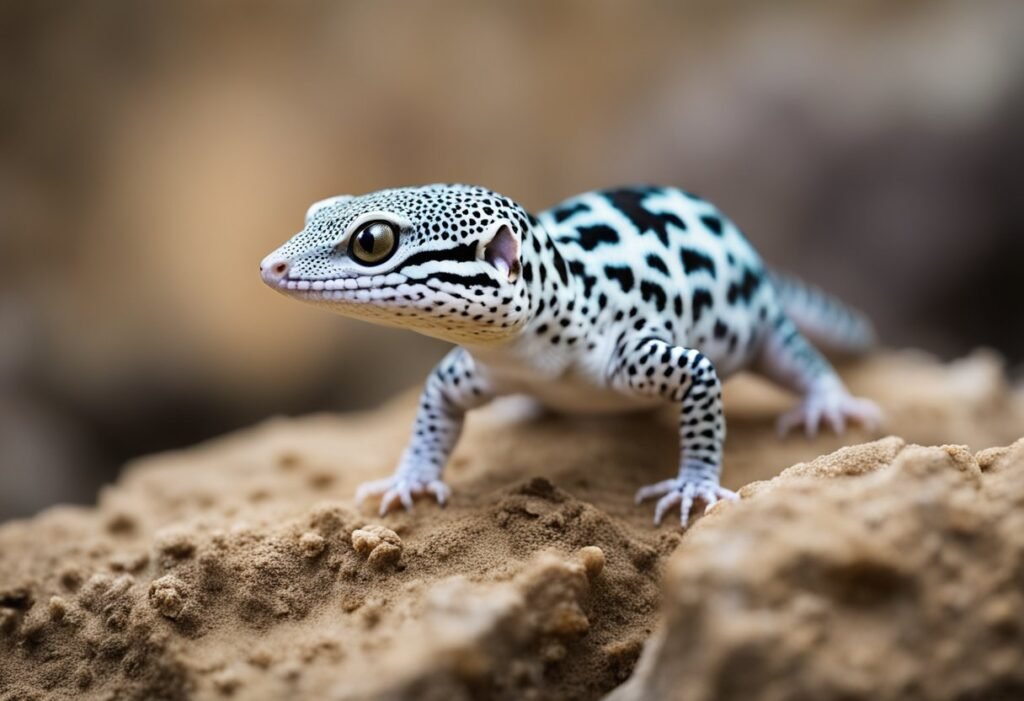
When it comes to feeding leopard geckos, crickets are one of the most popular food choices. However, not all cricket foods are created equal. In this section, we will discuss the different types of cricket foods and what they can offer your leopard gecko.
Commercial Cricket Foods
Commercial cricket foods are specially formulated to provide a complete and balanced diet for crickets. They usually contain a mix of grains, vegetables, and protein sources, such as soy or fish meal. These foods can be a convenient option for leopard gecko owners as they eliminate the need to gut-load crickets before feeding them to your gecko. However, it is important to note that not all commercial cricket foods are equal. Some may contain fillers or low-quality ingredients, so it is important to read the label and choose a high-quality brand.
Gut-Loading Foods
Gut-loading is the process of feeding crickets a nutritious diet before feeding them to your leopard gecko. This ensures that your gecko is getting the maximum nutritional benefit from their food. Gut-loading foods can include a variety of fruits, vegetables, and grains, such as carrots, sweet potatoes, and oats. It is important to avoid feeding crickets foods that are high in fat or sugar, as this can be harmful to your leopard gecko.
Calcium and Vitamin Supplements
Leopard geckos require calcium and vitamin supplements to maintain their health. This is especially important if you are feeding them crickets as their primary food source. Calcium supplements can be provided in the form of calcium powder, which can be dusted onto the crickets before feeding. Vitamin supplements can also be added to the diet to ensure that your gecko is getting all the nutrients they need.
In conclusion, understanding the different types of cricket foods is important for providing your leopard gecko with a healthy and balanced diet. By choosing high-quality commercial cricket foods, gut-loading crickets, and providing calcium and vitamin supplements, you can ensure that your gecko is getting all the nutrients they need to thrive.
Benefits of Cricket Foods for Leopard Geckos

When it comes to feeding leopard geckos, cricket foods are a popular choice among pet owners. In this section, we will discuss the benefits of cricket foods for leopard geckos.
Nutritional Value
Crickets are a great source of protein, which is essential for the growth and development of leopard geckos. They also contain other important nutrients such as calcium, phosphorus, and vitamins. These nutrients are important for maintaining healthy bones, teeth, and overall health.
Digestibility
Another benefit of cricket foods for leopard geckos is their digestibility. Crickets are easily digestible and can be broken down by the gecko’s digestive system. This means that the gecko can absorb the nutrients from the crickets more efficiently.
Feeding Behavior
Leopard geckos are natural hunters and enjoy chasing and catching their prey. Feeding them live crickets can help stimulate their natural feeding behavior and provide them with mental and physical stimulation. Additionally, feeding live crickets can help prevent boredom and encourage exercise.
In conclusion, cricket foods are a great choice for feeding leopard geckos due to their nutritional value, digestibility, and ability to stimulate natural feeding behavior. It is important to ensure that the crickets are gut-loaded and dusted with calcium and vitamin supplements before feeding them to the gecko.
Preparing Cricket Foods for Leopard Geckos
When it comes to feeding our leopard geckos, it is important to ensure that their diet is well-balanced and nutritious. One of the most popular food sources for leopard geckos is crickets, which are readily available and easy to prepare. Here are a few tips on how to prepare cricket foods for your leopard geckos:
- Gut-load the crickets: Before feeding the crickets to your leopard geckos, it is important to ensure that they are well-fed. This can be achieved by feeding them a nutritious diet, such as fresh fruits and vegetables, for at least 24 hours before feeding them to your leopard geckos. This will ensure that the crickets are packed with nutrients that your geckos need.
- Dust the crickets: In addition to gut-loading the crickets, it is also important to dust them with a calcium and vitamin supplement. This will ensure that your leopard geckos are getting all the necessary nutrients they need to stay healthy. It is recommended to dust the crickets with a supplement at least once a week.
- Remove uneaten crickets: After feeding your leopard geckos, it is important to remove any uneaten crickets from their enclosure. This will prevent the crickets from hiding and potentially causing harm to your geckos. It will also prevent any uneaten crickets from rotting and causing an unpleasant odor in the enclosure.
Overall, preparing cricket foods for leopard geckos is a simple and straightforward process. By gut-loading and dusting the crickets, and removing any uneaten crickets, you can ensure that your geckos are getting a well-balanced and nutritious diet.
Feeding Schedule and Quantities
When it comes to feeding leopard geckos, it’s important to establish a feeding schedule and stick to it. We recommend feeding juvenile leopard geckos daily, while adult leopard geckos can be fed every other day. It’s important to note that leopard geckos are nocturnal, so they should be fed in the evening or at night.
As for quantities, it’s important to feed your leopard gecko an appropriate amount of food. A general rule of thumb is to feed your leopard gecko as many insects as they can eat in 15-20 minutes. Overfeeding can lead to obesity, which can cause health problems for your leopard gecko.
When it comes to the type of food, leopard geckos are primarily insectivores and should be fed a variety of insects such as crickets, mealworms, and dubia roaches. It’s important to gut-load your insects with nutritious food before feeding them to your leopard gecko. This ensures that your leopard gecko is getting the necessary nutrients from their food.
In addition to gut-loading, it’s important to dust your insects with calcium and vitamin D3 supplements. This helps to prevent calcium deficiencies and metabolic bone disease in leopard geckos.
Overall, establishing a feeding schedule and feeding appropriate quantities of gut-loaded, supplemented insects is essential for the health and well-being of your leopard gecko.
Potential Risks of Feeding Cricket Foods
When it comes to feeding leopard geckos, cricket foods are a popular choice due to their high protein content and availability. However, there are some potential risks associated with feeding cricket foods that leopard gecko owners should be aware of.
Overfeeding
One of the main risks of feeding cricket foods is overfeeding. Leopard geckos have a tendency to eat as much as they can, which can lead to obesity and other health problems. It is important to feed leopard geckos the appropriate amount of cricket foods based on their age, size, and activity level.
Nutritional Imbalances
Another risk of feeding cricket foods is nutritional imbalances. While cricket foods are high in protein, they may not provide all of the necessary nutrients that leopard geckos need to thrive. It is important to supplement cricket foods with other types of food, such as mealworms, waxworms, and vegetables, to ensure that leopard geckos are getting a balanced diet.
Choking Hazards
Lastly, there is a risk of choking when feeding cricket foods. Leopard geckos may accidentally ingest pieces of cricket exoskeletons or other debris, which can cause blockages in their digestive system. To prevent choking hazards, it is important to feed leopard geckos appropriately sized cricket foods and to provide a clean feeding area.
In summary, while cricket foods can be a nutritious and convenient option for feeding leopard geckos, it is important to be aware of the potential risks associated with them. By feeding leopard geckos the appropriate amount of cricket foods, supplementing their diet with other foods, and providing a clean feeding area, we can help ensure their health and well-being.
Alternatives to Cricket Foods
Mealworms
Mealworms are a popular alternative to cricket foods for leopard geckos. They are easy to find in most pet stores and are relatively inexpensive. Mealworms are also high in protein and fat, which makes them a great source of nutrition for your gecko.
However, mealworms should not be the only food source for your leopard gecko. They are low in calcium, which can lead to metabolic bone disease if your gecko does not receive enough calcium from other sources.
Dubia Roaches
Dubia roaches are another alternative to cricket foods that are becoming increasingly popular among leopard gecko owners. They are high in protein and calcium, making them a great source of nutrition for your gecko.
Dubia roaches are also easy to digest, which can be beneficial for geckos with digestive issues. They are also less likely to carry parasites than crickets, which can be a concern for some gecko owners.
Commercial Diets
There are several commercial diets available for leopard geckos that can be used as an alternative to cricket foods. These diets are usually made from a combination of fruits, vegetables, and protein sources such as insects or meat.
Commercial diets can be a convenient option for gecko owners who do not want to deal with live insects. However, it is important to choose a high-quality diet that provides all of the necessary nutrients for your gecko.
In conclusion, there are several alternatives to cricket foods that can be used to provide your leopard gecko with a well-balanced diet. It is important to offer a variety of foods to ensure that your gecko receives all of the necessary nutrients for optimal health.
Monitoring Your Leopard Gecko’s Health
As responsible pet owners, it is important to monitor our leopard geckos’ health regularly. Here are some things to keep an eye on:
Appetite
Leopard geckos are known for their healthy appetites, so a sudden decrease in appetite could be a sign of illness. If your gecko stops eating or is eating significantly less than usual, it’s important to take them to a veterinarian.
Weight
Regularly weighing your gecko can help you keep track of their health. A sudden weight loss or gain could be a sign of illness or improper nutrition. It’s important to weigh your gecko on a regular basis and keep track of any changes.
Shedding
Leopard geckos shed their skin regularly, so it’s important to monitor their shedding process. If your gecko is having trouble shedding or if their skin appears dry or discolored, it could be a sign of illness or improper humidity levels in their enclosure.
Behavior
Changes in behavior can also be a sign of illness. If your gecko is lethargic, unresponsive, or acting differently than usual, it’s important to take them to a veterinarian.
By monitoring your leopard gecko’s health regularly, you can catch any potential health issues early and ensure that your pet stays healthy and happy.
Frequently Asked Questions
What are the best dietary options for leopard geckos?
Leopard geckos are insectivores, which means that they require a diet consisting primarily of insects. Some of the best dietary options for leopard geckos include crickets, mealworms, and dubia roaches. It is important to provide a variety of insects to ensure that your leopard gecko is receiving all of the necessary nutrients.
How frequently should leopard geckos be fed?
Leopard geckos should be fed daily when they are young, and every other day when they are adults. It is important not to overfeed your leopard gecko, as this can lead to obesity and other health problems.
Are there any vegetables suitable for leopard geckos?
Leopard geckos are primarily insectivores and do not require vegetables in their diet. While some vegetables may be offered as a treat, they should not make up a significant portion of their diet.
Is it safe for leopard geckos to consume mealworms?
Mealworms are a common staple in the diet of leopard geckos and are generally safe for them to consume. However, it is important to offer mealworms in moderation, as they have a hard exoskeleton that can be difficult for leopard geckos to digest.
What insects should be avoided in a leopard gecko’s diet?
Leopard geckos should not be fed insects that are high in fat, such as waxworms and superworms, as these can lead to obesity and other health problems. Insects that are too large, such as adult crickets or large mealworms, should also be avoided, as they can cause impaction.
Can leopard geckos include grasshoppers in their diet?
While grasshoppers are not a common food item for leopard geckos, they can be offered as a treat. However, it is important to ensure that the grasshoppers are not too large and that they are gut-loaded with nutritious foods before being offered to your leopard gecko.

